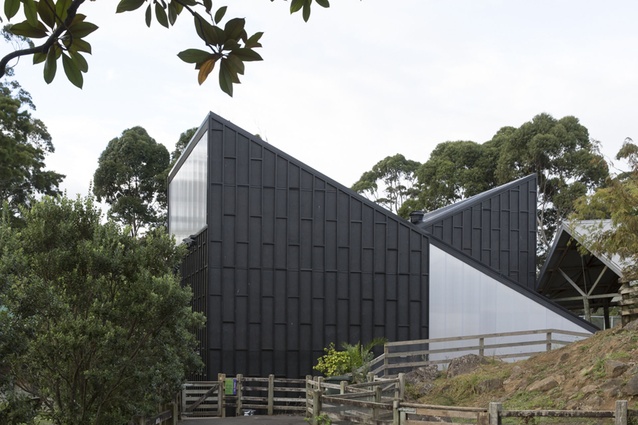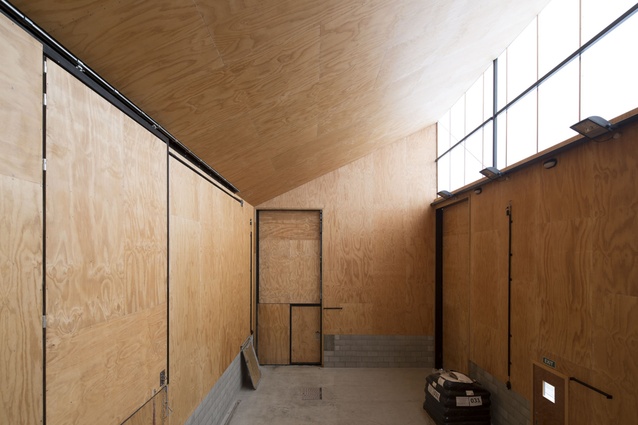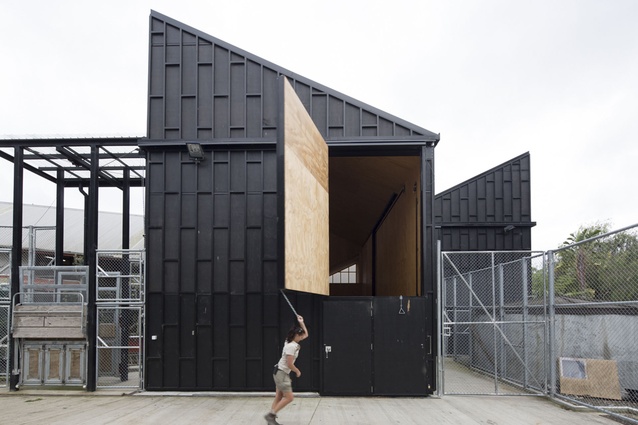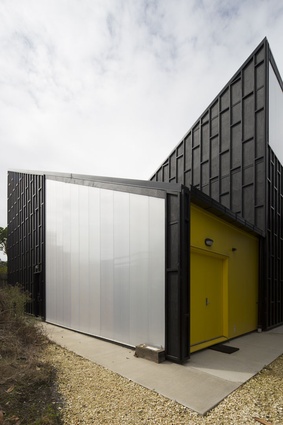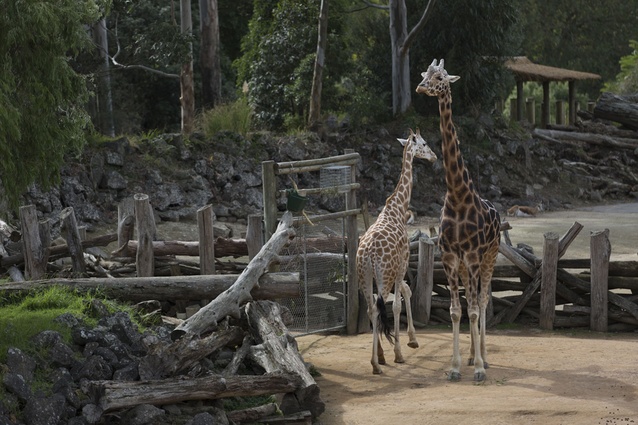Auckland Zoo Giraffe House
The intersecting anatomy of roof forms on Monk Mackenzie and Glamuzina Paterson Architects’ new giraffe boudoir encourages the world’s tallest terrestrial mammals to copulate.
Designing a house can be a real challenge when your client not only is
the tallest creature on earth but has a propensity for unscrewing light bulbs with her tongue. This new Giraffe House at Auckland Zoo is a collaboration between Monk Mackenzie and Glamuzina Paterson Architects as well as being a tribute to Auckland City, given that we could have ended up just with a shed rather than with decent architecture. The zoo saw the giraffe den as essentially a back-of-house breeding shelter on a tight site with no public access.
There is a long history of successful zoo buildings with the London Zoo, in particular, being the site of modern icons such as Berthold Lubetkin’s Penguin Pool; its double-helix ramps seem more functionally appropriate for waddling penguins than does Le Corbusier’s exercise in ramp gymnastics of the same period at the Villa Savoye. Mind you, when the penguins were temporarily relocated to a duck pond during refurbishment of the Penguin Pool, they enjoyed it so much they took up permanent residence and Lubetkin’s building remains a Grade 1 English Heritage-listed, but empty, historic building. I haven’t spoken to the giraffes at Auckland Zoo but the keepers seem happy with their building.
The building was, as mentioned before, conceived by the zoo as a low-budget, background structure, providing keeper access and two dens for giraffes. But buildings like this seem to open up possibilities in architectural form and, while the structure on its constrained L-shaped site is simple in plan, the two clerestory roofs that soar in counterpoint seem to abstractly reflect the verticality and forms of a couple of giraffes: their thick bodies tapering gracefully up to tall points. The exterior board and batten treatment of the Shadowclad also provides a patterning reminiscent of that of a giraffe, although the building is mainly black as the zoo favoured a recessive appearance.
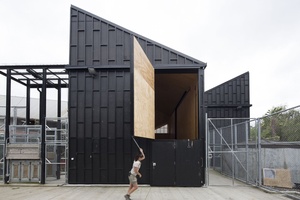
Some may think these roof shapes give the building a slightly chapel-like appearance but the reality is more carnal; the intersecting anatomy of these forms reflects one of the purposes of the house, which is to encourage the world’s tallest terrestrial mammals to copulate. The architects can be congratulated not just for designing a giraffe boudoir but for adding a formal metaphor for sexual intercourse to our repertoire of architectural language. However, I suspect zoo staff may not be aware of this architectural interpretation – otherwise, surely this building wouldn’t be permitted to lurk so closely to the zoo’s KidZone facilities. Still, a zoo is for learning about “nature, raw in tooth and claw” as Tennyson put it and, recently, at Copenhagen Zoo a young giraffe called Marius was shot, chopped up and fed to lions in front of a crowd of wide-eyed youngsters. Sorry kids, life can be yukky; it’s not all cute meerkats and cuddly guinea pigs.
Inside the Giraffe House, the two different scales of giraffe and human collide. We enter on the low side but the roof soars from 3m to 10m in order to accommodate 6m-high giraffes, which are used to having only sky above their heads. The keepers’ area is a small room protected from the dens with a mezzanine above, accessed by a glowing yellow stairway. This level services feed troughs and allows vets to have face time with their clientele and inspect their ossicones. I was assured that, despite its slow-motion grace, a grumpy giraffe can give you a good hoofing, and a kick from one of these beasts can decapitate a lion. Hard to believe, however, as, from my observations, the lifestyle of the average giraffe does generally seem to be a fairly languid affair. Even the ritual where two males ‘fight’ to assert dominance and sort out who gets the girl, is called ‘necking’: leaning on each other and giving your adversary a good bump. Due to its high centre of gravity, the giraffe’s main challenge, familiar to anyone who had a plastic toy one as a youth, is to avoid falling over. As you can imagine, the veldts of the giraffe’s homeland are fairly flat, so the design of their house had to avoid any undulations, steps or steep ramps.
Untreated ply lines the interior of the enclosure and the huge sliding doors have a number of hinged panels, meaning the dens and their openings can be configured in a number of ways and, also, the dens can open to separate yards. Although the whole complex is fairly simple in plan and uses economical materials, the doors, both internal and exterior, required a great deal of work by the manufacturers, Design Production. Giraffes have clever tongues and these half-metre-long prehensile bundles of muscle can work their ways through gaps, unlock bolts and create mischief.
However, giraffes can be sensitive creatures. At one stage during construction, they became quite upset when a blue digger they had grown fond of disappeared. It had to be brought back so the giraffes could be weaned off its absence. But, even from my anthropocentric point of view, the light entering through polycarbonate sheeting high up on the clerestories of their dens creates a luminous glowing space that must help pacify any giraffes who find themselves booked into the accommodation here for whatever reason. They have found new friends in their architects who have designed a serene pavilion in these zoological gardens; would that there were more houses in suburban Auckland as simple, economical and gracious as this.

